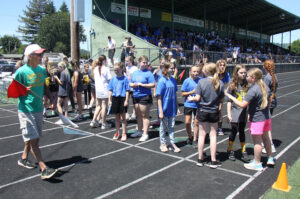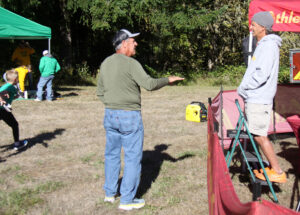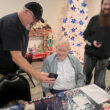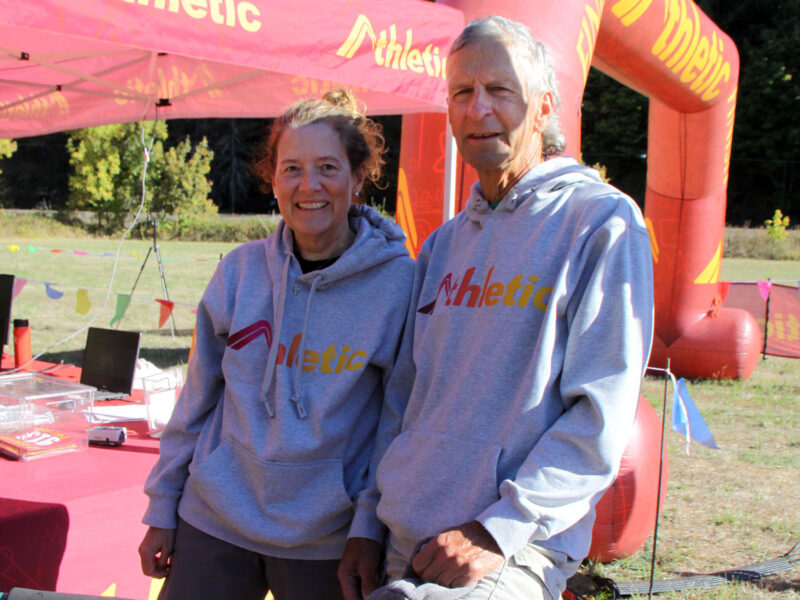When Billy and Barb Snow retired from their teaching jobs, they really didn’t expect to spend their retirement at high school and college tracks.
But as a longtime coach at Sweet Home, Billy had a lot of experience with track and cross-country meets, so maybe it shouldn’t be surprising that they found their way back to the world of high school running – in a different context.
Last Saturday the Snows sat under a canopy emblazoned with “Athletic.net” logos, recording the results of a small cross-country meet being hosted by the Huskies.
They were in their element.
“It’s just been a way for us to stay connected to a sport that gave me a lot of joy, being involved in it,” Billy Snow said.
Billy, 73, “going on 74,” retired from teaching in 2014, although he continued to coach track and field at Sweet Home until 2016, because “they had trouble finding a track coach” to head the program he’d led since the mid-1990s.
Eventually, though, he retreated to the home in the Liberty-area forest, where he and Barb had raised their four kids, Megan, Erika, Jessica and Dakota, and retired – or so he thought.
Barb, who had taught math for some 30 years at Seven Oak Middle School in Lebanon, retired when COVID forced her into remote teaching, Billy said.
“She was facing that, going back and she said ‘No, that’s not me,’” he said.
Both Billy and Barb, who’s now 63, grew up participating in athletics. Billy grew up in Ohio playing football and running track. When he graduated, he didn’t go to college right away, he said.
Instead, he worked, eventually landing a job with the U.S. Forest Service in the mid-1970s that took him to the wildlands of Oregon. He liked it here.

Along the way, he started playing on a men’s volleyball team.
“I wasn’t very good.”
He was attending Oregon State University when he decided he needed to work on his conditioning.
“I could walk for miles, but I decided to start running to get in shape.”
He remembers wearing a pair of the black Converse shoes, popular then, and he signed up for a class taught by Bill Winkler, the Oregon State physical education professor and fitness guru, called “Marathon Training.”
It changed his life, connecting him with people who became his friends and workout buddies.
“Every quarter we signed up to work out,” he said. “A lot of our training was racing because we didn’t like to lose.”
His first road race was the Seaside Marathon.
“I had no clue what I was doing,” Snow said. “The weather was terrible and the wind was blowing because a big storm was coming in. We ran out toward Gearhart with the wind at our backs, then we ran with the wind in our faces coming back.”
He finished the 26.2 miles in 3 hours and 15 minutes, a credible time under those conditions.
“I felt fine, maybe a little stiff,” Snow said. He kept going, on to many more road races, many run with his former athletes and his daughter Megan and her family.
He continues to run, often in often in the hills behind his house, three to five times a week, he said.
His top reason for running is “enjoyment,” followed by the fact that there’s a history of heart problems in his family.
“I figure running will help hold that off,” Snow said.
Barb Snow was a tennis player in high school, but after she married Billy and their kids got older, she started running as well.
“It’s something we could share together,” Billy said.
Snow has always been interested in track and field statistics; since 1999 he and current Sweet Home cross-country Coach Dave Martin have produced a bound, inch-thick annual encyclopedia of the previous season’s high school track and field performances entitled “Who’s Who in Oregon Track and Field.”
After he and Barb retired, Billy got an email from an acquaintance at athletic.net, an online sports information platform developed by Dan Bowdoin, the track coach at tiny New Hope Christian School in Grants Pass.
Snow was the second coach to use the program, which tracks athletes’ performances and is now used throughout Oregon and much of the nation to manage competitions and record athletes’ times and marks in track and field and cross-country. So he’s been in on the ground floor, so to speak, from the beginning.
But now he was being asked to be a player, not just a user.
The program has become increasingly popular in recent years and athletic.net now manages track meets and road races, provides timing and results recording for events.
Athletic.net was expanding its services and it needed help. The Snows were asked if they would be interested in working at track meets. They decided to give it a shot.
He said it took them a couple of years – and a lot of phone calls – to figure out how to run the equipment – computers, timers, cameras and sensors, which are used to record results for competitions.
 This past spring, though, “was actually a pretty good year,” he said. “We got the setup down and we didn’t have any major problems.”
This past spring, though, “was actually a pretty good year,” he said. “We got the setup down and we didn’t have any major problems.”
This past season they worked three or four meets a week, he said.
“We can determine how busy we want to be,” he said.
“It’s a way to stay connected with the sport, beyond just the ‘Who’s Who in Oregon Track and Field’ book.”
The Snows also like being able to stay connected with kids and old associates in the sport.
“It gives me a feel for the kids involved in the programs and we love to go to different schools and programs, where we run into people I coached with, who are still coaching or retired and just volunteering.”
Track and field, where they spend most of their athletic.net time, is different from cross-country because meets tend to be significantly more intense – multiple events going on simultaneously, Snow said.
“It’s pretty intense for two months, but part of the joy of track and field is the intensity.”
Plus, they get paid for working the meets.
Snow said people don’t realize how much preparation goes into setting up for a meet, including “lots of communication” and sometimes multiple weeks of set-up.
“You go to a meet as a spectators, you think, ‘Man, these people know what they’re doing.’ Behind the scenes, it’s not always smooth sailing.”
In the end, though, he and Barb are doing something they love, he said.
“It’s just been a way to stay connected to a sport that gave me a lot of joy, being connected with it.”





